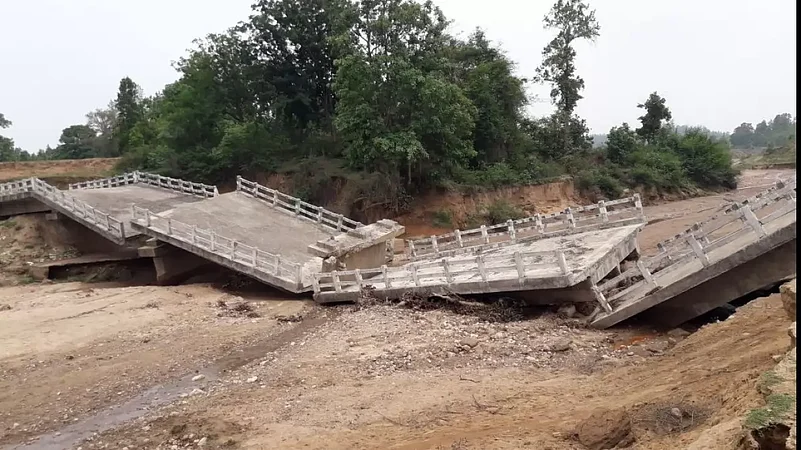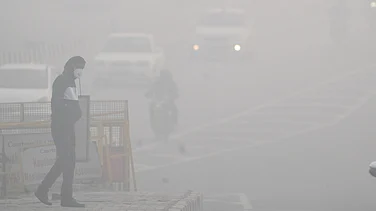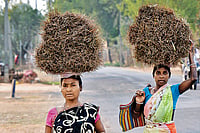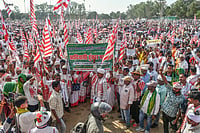Phulmait Devi, 52, lived in the tribal-dominated Naktijhariya village, 30 km away from Raidih block, which is in Gumla district of Jharkhand. On July 15, she died for want of proper medical treatment. According to the villagers, had Phulmait been taken to the hospital on time, her life could have been saved. However, due to the absence of any road or pulia (bridge), that could not happen. Every year, during the rainy season, the Naktijhariya village gets marooned.
“Phulmait was not keeping well for many days. When her health deteriorated all of a sudden, we could not make it to the hospital in time. There is no road, electricity or water supply in the village,” says Sahdev Kisan, 34, a resident of the village.
In order to take her to the hospital, the villagers would first have had to walk to the Kobja Panchayat and then take an auto to reach the hospital in Raidih block. They have to cross a small brook to reach Kobja but it was completely submerged that day due to incessant rain. “We somehow carried Phulmait, tied in a blanket, through the other road to Jashpur (which falls in the neighbouring Chhattisgarh, close to Gumla). However, it was too late. She could survive only for a day at the hospital. She died the next morning,” informs Kisan.
According to Sahdev, Naktijhariya village, which has a population of more than 500, is devoid of any government facility. The villagers want a small pulia and road to be constructed so that they can commute even during monsoon.
There are 10-12 villages that are not connected at all, informs Amit Mishra, the Block Development Officer (BDO). “There are no roads in these villages. Even motorbikes can’t enter. We visited Naktijhariya on July 15 with the junior engineer. We made an estimate for the construction of the road which will be sending the DC. This will help the villagers in getting a road for commutation.”
According to residents of Naktijhariya village, they buy ration in bulk many days in advance of before the monsoons. The villagers fetch drinking water from small streams and brooks. However, this water is not safe for drinking during the monsoon and they contract different water-borne diseases.
Gumla district is around 100 kms away from Jharkhand’s capital city Ranchi. According to a report published in state’s popular newspaper Prabhat Khabar, around 200 villages in five blocks of Gumla, including Raidih, turn into small islands during the rainy season. The lives of the people living in these villages come to a complete standstill. For three months, they are unable to move out of their villages. People stock eatables in their houses in advance. The absence of pulias connecting villages is the prime reason for this. Many a time, the villagers put their lives in danger to meet their urgent needs.
“There are many villages that face the problem of connectivity. We do not receive the fund on the scale that is being covered in the news. Districts need a big budget. Only then we can construct small pulias,” says Sushant Gaurav, DC, Gumla. “Right now whatever funds we receive, they get exhausted at the lower level. There are many small pulias being constructed and many are in the pipeline. In the near future, 20 to 25 small and big pulias will get constructed and a sum of Rs 11 crore is being spent on this. The media does not cover those issues that get mitigated.”
Latehar district lies adjacent to Gumla district. Mahuadanr block has around a dozen villages, including Latu, Goalkhand, Udalkhar, Datukhar, Ijotkhar, Bala Mahua, Sarkai Path, Jamdih. The absence of pulias creates a problem for the people of these villages.
Kishun Nagesiya, a resident of Jamadih, says: “During the rainy season, the village loses its connectivity. We cannot go to Mahuadanr market. If someone falls sick, we have to take the long route of 50 km through Chhattisgarh to reach Mahuadanr. The unmetalled road that we construct through our voluntary contribution of labour gets washed away in the rains. We have around 200 houses in the village. If roads get constructed our lives will become much easier.”
Like Gumla and Latehar, Simdega is also a tribal-dominated district. In the Pakartar block, too, many villages turn into islets during the rainy season. According to a report in Hindustan newspaper, the roads connecting Lainlonga and Katasaru villages to Pakartar block and district headquarter are presently submerged in water. The villagers inform that for decades, their villages have been getting disconnected from the outside world during the rainy season. Children stop going to school and many times, patients lose their lives. The authorities and block officers only give assurances instead of getting these pulias made.
The Kolhan block of the West Singbhum district of Jharkhand is known for its tribal population and mineral resources. Good-quality iron ore deposits are found in the Saranda forest. Several villages of Manoharpur block of West Singbhum district have to suffer a great deal owing to rains. Due to mining activity, the source of natural water supply here gets polluted leading to life-threatening diseases. Secondly, the absence of bridges and roads disconnects them from marketplaces.
Kameshwar Manjhi, 34, is a resident of Bahda village of Manoharpur block. He says that in the last three years, there have been two deaths due to the absence of pul-pulia and roads. “From the time of my birth till date, I have been witnessing this situation. During the rainy season, when the river gets flooded, we are unable to go to markets for weeks. Vehicles can’t enter. If someone falls sick, we carry the patient on a cot. Due to this process of commutation, two people had lost their lives in a span of three years. We are tired now,” he says.
The villagers have submitted more than a dozen requests to Member of Parliament Geeta Koda, Chief Minister Hemant Soren and erstwhile CM Raghubar Das. These requests have also been submitted to the DC around 5-6 times. Nothing has changed on the ground, informs Kameshwar.
There are many departments in Jharkhand that are behind schedule to exhaust the budget fund allocated to them. This includes the Rural Development department too. In 2021-2022, out of the total budget allocated, Rs 15,000 crore was not spent.
As a result, the amount had to be surrendered. In 2022-2023, in the span of 10 months, only 47 per cent of the total amount has been spent. However, in 2023-24, out of the budgetary allocation of Rs 1.16 lakh crore, till June 30, Rs 17,900 crore have been spent.
On the issues of budget and villages, Jharkhand Rural Development Minister Alamgir Alam, says: “We do not construct small pulias. These are constructed by the district administration. Only some villages in Gumla face connectivity issues during monsoon. These issues will definitely be resolved,” he says.
“New projects are being planned to develop rural areas of Jharkhand. Many puls are being constructed. As far as the budget is concerned, work could not be completed due to the pandemic and so the whole budget amount could not be utilised. In 2022-23, we had spent 65 per cent of the budget amount. This year we have spent 72 per cent of the budget amount till now.”
Translated by Kaveri Mishra



























